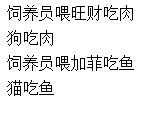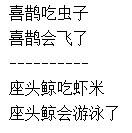多态
1. 概念
- 同一个对象,在不同时刻,表现出不同的形态.(父类类型的变量,保存了子类类型的对象.)
2. 多态的前提
- 要有继承或实现关系;
- 要有方法的重写;
- 要有父类引用指向子类对象;
例:
class Animal {
public void eat() {
System.out.println("动物吃东西");
}
}
//1. 猫类继承动物类, 有继承关系
class Cat extends Animal {
//2. 有方法重写
@Override
public void eat() {
System.out.println("猫吃鱼");
}
}
public class AnimalDemo {
public static void main(String[] args) {
//3. 有父类引用指向子类对象
Animal a = new Cat();
a.eat();
}
}
3. 成员访问特点
① 成员变量
- 编译看父类,运行看父类
② 成员方法
- 编译看父类,运行看子类
4. 多态的好处和弊端
① 好处
- 提高程序的扩展性。定义方法时候,使用父类型作为参数,在使用的时候,使用具体的子类型参与操作
② 弊端
- 不能使用子类的特有成员
5. 多态的案例
- 请采用多态的思想实现饲养员饲养动物,并在测试类中进行测试
// 动物类
class Animal {
private String name;
private int age;
public String getName() {
return name;
}
public void setName(String name) {
this.name = name;
}
public int getAge() {
return age;
}
public void setAge(int age) {
this.age = age;
}
public void eat() {
System.out.println("动物要吃饭");
}
}
// 狗类, 继承动物类
class Dog extends Animal {
@Override
public void eat() {
System.out.println("狗吃肉");
}
}
// 猫类, 继承动物类
class Cat extends Animal {
@Override
public void eat() {
System.out.println("猫吃鱼");
}
}
// 饲养员类,
class Feeder {
// 喂养动物的方法
public void feed (Animal a, String food) {
System.out.println("饲养员喂" + a.getName() + "吃" + food);
}
}
// 测试类
public class Test {
public static void main(String[] args) {
// 创建动物对象, 多态的形式
Animal dog = new Dog();
dog.setName("旺财");
Animal cat = new Cat();
cat.setName("加菲");
// 创建饲养员对象
Feeder feeder = new Feeder();
// 饲养动物
feeder.feed(dog, "肉");
dog.eat();
feeder.feed(cat, "鱼");
cat.eat();
}
}
运行结果:

抽象类
1. 概念
- 当我们在做子类共性功能抽取时,有些方法在父类中并没有具体的体现,这个时候就需要抽象类了!
- 在Java中,一个没有方法体的方法应该定义为抽象方法,而类中如果有抽象方法,该类必须定义为抽象类!
2. 特点
① 抽象类和抽象方法必须使用 abstract 关键字修饰
//抽象类的定义
public abstract class 类名 {}
//抽象方法的定义
public abstract void eat();
② 抽象类中不一定有抽象方法,有抽象方法的类一定是抽象类
③ 抽象类不能实例化
- 抽象类如何实例化呢?参照多态的方式,通过子类对象实例化,这叫抽象类多态
④ 抽象类的子类
- 要么重写抽象类中的所有抽象方法
- 要么是抽象类
3. 抽象类案例
abstract class Animal {
private String name;
private int age;
public Animal() {
}
public Animal(String name, int age) {
this.name = name;
this.age = age;
}
public String getName() {
return name;
}
public void setName(String name) {
this.name = name;
}
public int getAge() {
return age;
}
public void setAge(int age) {
this.age = age;
}
public abstract void eat();
}
class Cat extends Animal {
public Cat() {
}
public Cat(String name, int age) {
super(name, age);
}
@Override
public void eat() {
System.out.println("猫吃鱼");
}
}
public class AnimalDemo {
public static void main(String[] args) {
//创建对象,按照多态的方式
Animal a = new Cat();
a.setName("加菲");
a.setAge(5);
System.out.println(a.getName()+","+a.getAge());
a.eat();
System.out.println("--------");
a = new Cat("加菲",5);
System.out.println(a.getName()+","+a.getAge());
a.eat();
}
}
接口
1. 概念
- 接口就是一种公共的规范标准,只要符合规范标准,大家都可以通用。
- Java中的接口更多的体现在对行为的抽象!
2. 特点
- 接口用关键字interface修饰
public interface 接口名 {}
- 类实现接口用implements表示
public class 类名 implements 接口名 {}
- 接口不能实例化
接口如何实例化呢?参照多态的方式,通过实现类对象实例化,这叫接口多态。
多态的形式:具体类多态,抽象类多态,接口多态。 - 接口的子类
要么重写接口中的所有抽象方法
要么子类也是抽象类
3. 接口的案例
- 创建动物类作为父类, 创建鸟类和鱼类, 创建游泳接口和飞翔接口, 让鸟类和鱼类继承动物类,并且鸟类实现飞翔接口, 鱼类实现游泳接口
// 创建动物类
abstract class Animal {
private String name;
private int age;
public Animal() {
}
public Animal(String name, int age) {
this.name = name;
this.age = age;
}
public String getName() {
return name;
}
public void setName(String name) {
this.name = name;
}
public int getAge() {
return age;
}
public void setAge(int age) {
this.age = age;
}
public abstract void eat();
}
// 飞翔接口
interface Fly {
void fly();
}
// 游泳接口
interface Swim {
void swim();
}
// 鸟类, 继承Animal, 实现Fly接口
class Bird extends Animal implements Fly {
@Override
public void eat() {
System.out.println(getName() + "吃虫子");
}
@Override
public void fly() {
System.out.println(getName() + "会飞了");
}
}
// 鱼类, 继承Animal, 实现Swim接口
class Fish extends Animal implements Swim {
@Override
public void eat() {
System.out.println(getName() + "吃虾米");
}
@Override
public void swim() {
System.out.println(getName() + "会游泳了");
}
}
// 测试类
public class Test {
public static void main(String[] args) {
// 创建动物对象, 多态形式
Animal bird = new Bird();
bird.setName("喜鹊");
Animal fish = new Fish();
fish.setName("座头鲸");
// 调用方法
bird.eat();
((Bird)bird).fly();
System.out.println("----------");
fish.eat();
((Fish) fish).swim();
}
}
运行结果:

